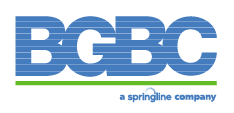Highlights
- The American Rescue Plan Act provides for a 100 percent premium subsidy for certain former employees from April 1, 2021 to Sept. 30, 2021 and provides a second chance for some individuals to elect COBRA health insurance coverage
- Employers will be responsible for complying with notice requirements for eligible former employees during the premium subsidy period.
- Employers will be eligible for a refundable tax credit to offset amounts paid under the COBRA subsidy provisions of the American Rescue Plan Act.

The recently signed American Rescue Plan Act (ARPA) will have a major impact during the next six months on employers’ obligations and considerations in administering COBRA health insurance benefits. Subtitle F of ARPA – Preserving Health Benefits for Workers – provides a six-month COBRA premium subsidy for certain qualified beneficiaries commencing on April 1, 2021. Within the next several weeks, employers will need to review their records in order to provide required notices and ensure they are following compliance with the revisions. Meanwhile, guidance from the Internal Revenue Service (IRS) and U.S. Department of Labor (DOL) is needed, and expected to be provided early next month, and model notices should be published by April 10, 2021. A brief summary of the subsidy requirements is highlighted below.
Who Is Eligible?
In response to the high number of furloughed and laid-off employees as a result of the COVID-19 pandemic, many of whom lost employer-provided medical coverage and then could not afford the high costs of COBRA coverage, Congress included a temporary, 100 percent premium subsidy in ARPA for Assistance Eligible Individuals (AEI’s). ARPA defines an Assistance Eligible Individual as any individual that is a qualified beneficiary who is eligible for COBRA coverage between April 1, 2021, and Sept. 30, 2021, due to an involuntary termination of employment, if the AEI elects such coverage. Although the subsidy period ends on Sept. 30, 2021, AEI’s may elect to continue COBRA coverage by paying the premiums themselves up until the end of their applicable COBRA coverage term. Additional guidance is important to understand what circumstances constitute an involuntary termination, such as the distinction between a voluntary or involuntary reduction in hours. However, individuals that are eligible for Medicare or another group health plan are excluded from participation in the COBRA subsidy program.
Although ARPA does not extend the maximum 18-month COBRA coverage period, it does give some individuals a “second chance” to re-elect COBRA coverage in certain situations. Specifically, this group of individuals would include AEI’s whose statutory maximum COBRA coverage period has not yet concluded, but either did not elect COBRA coverage or elected but then discontinued coverage. These “second chance” AEI’s have an additional opportunity to elect COBRA coverage. However, an AEI who discontinued COBRA coverage and elects COBRA again will be allowed COBRA continuation coverage only for the remaining time of the original COBRA continuation coverage period. Employers should begin identifying impacted individuals entitled to COBRA since Nov. 1, 2019 and be prepared to identify others who are still within their COBRA coverage period, in order to comply with the notice requirements explained below.
Optional Change in Coverage Election
Employers may also choose whether to allow AEIs to enroll in a different medical plan than that which the employee participated in during employment. If an employer elects to provide this option, an AEI may not enroll in a plan with a higher premium than the plan the AEI was enrolled in at the time of the qualifying event, and enrollment in the plan must occur within 90 days of the date notice is given.
Notice Requirements
ARPA imposes three key notice requirements on employers with compliance deadlines that are rapidly approaching. First, before May 31, 2021, employers must notify AEIs who become eligible for premium assistance before April 1, 2021, that they may be entitled to premium-assisted COBRA coverage. If the employer chooses to permit AEIs to enroll in different coverage the general notice must also notify the recipient of that option. This same information needs to be provided to all individuals that become eligible for COBRA during the six-month subsidy period. Employers could choose to update their current COBRA notices with the required information or may choose to disperse supplemental notices in addition to their standard COBRA notification forms. As noted above, the DOL is expected to issue a model notice by April 10, 2021.
Employers will also be responsible for notifying the “second chance” individuals of their option to re-elect COBRA coverage by May 31, 2021. As the “second chance” moniker suggests, this special election notice must inform these individuals of their right to elect subsidized COBRA coverage even though their enrollment period has lapsed. The special election notices must be provided to affected individuals by May 31, 2021. The “second chance” AEIs as well as the individuals who become eligible for COBRA coverage during the subsidy period will have 60 days to elect coverage after the relevant notice is provided.
Finally, employers will also be responsible for notifying AEI’s when the COBRA premium assistance period is ending. These notices must be sent to AEI’s at least 15 days – but not more than 45 days – prior to the expiration of premium-assistance COBRA coverage. If an AEI’s premium-assistance coverage is ending because he or she has become eligible for health coverage through Medicare or a group health plan, then the expiration notice is not required. The Department of Labor is expected to issue a model expiration notice by April 25, 2021.
Subsidy Reimbursement
While the burden imposed by ARPA on plans and employers may be heavy, employers will be eligible for a refundable tax credit against the taxes imposed under Internal Revenue Code Section 3111(b), generally referred to as the Medicare tax. If the tax credit is refundable, employers may seek an advancement of funds. Further guidance from the IRS is expected concerning the tax credit.
Conclusion and Takeaways
ARPA has had major impacts on employers’ obligations and responsibilities regarding compliance requirements for COBRA coverage. Official guidance from the DOL and IRS is expected within weeks, and notice forms even sooner. To learn more about COBRA assistance under the American Plan Rescue Act, here is an article by LHD. If you have any questions about ARPA’s impact on your COBRA obligations, please contact BGBC Partners, LLP.
For more information on the impacts of the COVID-19 pandemic, visit our COVID-19 Resource Center.
Information contained in this alert is for the general education and knowledge of our readers. It is not designed to be, and should not be used as, the sole source of information.
